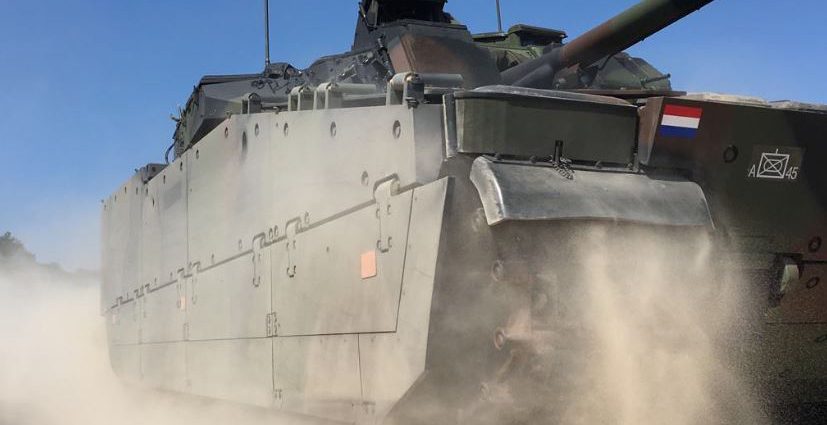BAE Systems’ recent award for the Dutch Army CV90 mid-life upgrade contract is in itself an important milestone for the company. But under the hood, a real revolution in Active Protection Systems (APS) is taking place – the first operational procurement of the Iron-Fist and a first NATO operator of an APS system. Built on technology developed over decades in the Israeli Military Industries (IMI) and acquired by Elbit, which propelled it to the finish line – setting the company as a lead contender for APS systems worldwide.
Elbit has grown impressively over the past decades, devouring mismanaged technological gems like the late Elop, Soltam, and Elisra, into what is now a business-aligned technological powerhouse. “They were all like unpolished diamonds. Sometimes the polishing took time, but each of these companies was a growth engine for the group,” says a defense industry executive. IMI or Israel Military Industries was established in 1933. It had important technological assets but failing government-owned management. Elbit Systems stubbornly pursued the acquisition of IMI for three years, while other companies in Israel and overseas withdrew, one by one, from the tender conducted by the state.
The merger with IMI gave Elbit Systems a foothold in spheres it has previously only dreamed about, such as precision rockets and cruise missiles, promising activity in active protection for tanks and AFVs, involvement in 30% of all of the IDF’s Merkava tanks and Namer AFVs, precision artillery shells, upgrading of tanks and AFVs, armoring and weapons stations, manufacturing of armored vehicles, etc. As if that were not enough, IMI also manufactures light ammunition for the IDF and foreign armies and has turned to additional markets in recent years. IMI has founded a line of premium products, including specially designed ammunition for special forces and types of ammunition adapted for the US civilian market.
IMI’s Iron-Fist Falters Bradley Integration
In 2017 the US Army determined it needed to field an interim APS solution for the Abrams tank as well as the Stryker and Bradley. The service decided to rapidly assess off-the-shelf APS systems to fulfill an urgent operational need after failing — over a 20 year period — to field an APS system. The Army selected three different systems: Israeli company Rafael’s Trophy system, which is deployed in the Israeli army, for Abrams; Iron Fist from IMI, another Israeli company, for the Bradley; and Herndon, Virginia-based Artis’ Iron Curtain for Stryker. While the Army has stayed on track with Abrams, due to a combination of earlier funding availability and qualifying an already fielded system, it has struggled to stay on schedule with the other two configurations.

Integrating Iron Fist onto Bradley has been the most challenging because the vehicle,did not have the power distribution to handle any APS system. The Army had to take components planned for a future Bradley upgrade in order to install Iron Fist onto the platform. So the schedule slipped in the beginning due to the power issue, however, later other issues have continued beyond surpassing that initial challenge.
“The problem was getting the contractor ready for tests and they have continued to have some challenges with their portion of the APS system, getting the logic to work and their software to work consistently, handling power management on the APS end of the project,” said a US Army source. The contractors each had time to tune their equipment once installed on the platforms before entering into official government characterization testing. The Army wrapped up the first phase of testing Iron Fist on Bradley in FY18, and the second phase of testing is scheduled for FY21.
The report notes the currently fielded Bradley A3 doesn’t generate enough power to operate the APS system, but that the Bradley A4 variant will support it. And while the APS system is the “Light Decoupled” version of Iron Fist, it adds approximately 1,543 pounds to the vehicle. But the Bradley’s power problem and the added weight wasn’t the issue that caused the need for tweaking Iron Fist. The first phase of testing revealed “an inconsistent capability” of the APS to intercept threats “largely due to countermunition dudding and power failures to the launcher,” the report stated. The power failures to the launcher have nothing to do with the A3 version of the Bradley, US Army sources said. “The test asset that we used for characterization testing was a modified A3 that was able to provide enough power to not only power the vehicle but to power the Iron Fist system as well.” . The power failures were actually internal to the Iron Fist system “in terms of a miscalculation of how much power the system needed to draw to orient itself to be able to engage the threat.
At that stage, Elbit had acquired IMI and the “mission-oriented, do whatever it takes” culture started prevailing. Elbit, together with its partner General Dynamics Ordnance and Tactical Systems was able to identify the reasons for the misses — and/or dudding and they were able to propose some fixes to the Army Requirements Oversight Council in 2018. The companies have largely addressed the concerns related to the inconsistencies in tests, and the Army is under contract to finish out the engineering and manufacturing development phase, which would allow the service to take several systems into testing for the upcoming Bradley A4 version. The Bradley A4 is an important upgrade to the Bradley that buys back capability lost over the years the vehicle has been in service. The Army is anticipating taking receipt of the first Bradley A4, along with several others, by the end of the month, he said. The vehicles will go into production verification tests in April followed by an operational test in September, he noted.
Iron Fist series of Active Protection Systems (APS) delivers protection against anti-tank threats while increasing the survivability of the platform or vehicle. The series includes a light configuration for armored fighting vehicles (AFV), infantry fighting vehicles (IFV) and logistic vehicles, and a heavier configuration for main battle tanks (MBT). The solutions provide interception of anti-tank threats by precise-detection technologies and capabilities to detect, identify, classify the threat, and respond to hostile fire threats in various engagement scenarios. The Iron Fist APS utilizes a blast interceptor to defeat the threat without initiating its warhead.
The Dutch Vote of Confidence
BAE Systems has now signed an extensive mid-life upgrade contract worth more than $500 million with the Dutch Defence Materiel Organization (DMO) for the Royal Netherlands Army’s fleet of 122 CV90s, with an option for an additional 19 vehicles.
The upgrade program with a new turret will vastly improve the vehicle’s capabilities while providing crews with improved protection and ergonomics for increased combat efficiency.
The new CV90 turret, developed by BAE Systems Hägglunds in Örnsköldsvik, Sweden, represents a leap forward in design and functionality. The main weapon position is changed to provide even better vehicle balance and enable new ways to introduce a variety of weaponry for increased lethality. It also offers significant ergonomic improvements to benefit the vehicle’s crew.
The enhanced turret design is built on years of combat-proven experience, continuous vehicle improvements, and data analysis from the CV90 User Club – the seven nations currently operating CV90 fleets. The improvements are also based on a recent study conducted by the Royal Netherlands Army, and a BAE Systems’ analysis of cognitive load on Infantry Fighting Vehicle (IFV) crews to address man-machine interaction. The result gives crews increased advantages, such as the ability to choose intuitive and effective modes of operation as well as shorten the time to detection, identification, decision-making, and engagement.
This modification is the latest in series of incremental upgrades to the Dutch CV90s. Most recently, in 2019, the Dutch Army selected BAE Systems to integrate the Elbit Systems’ Iron Fist Active Protection System (APS) into its fleet. Iron Fist is an advanced technology that automatically detects, tracks, and neutralizes incoming threats to protect the vehicle and its crew.
“This development is a real strategic milestone in the CV90’s approach to holistic survivability,” added BAE sources. “It complements the already existing stealth- and soft-kill layers with further means to defeat the incoming threat, making survivability even more achievable.”
In 2017 The Dutch Army contracted BAE to perform a test phase to pre-qualify the APS against threat specifications determined by the Netherlands’ Defence Ministry, which teed up a decision on the next phase of the program in early 2018.
As future operational scenarios evolve, it will be interesting to see if Elbit’s wager on the future of IMI’s self-protection system turned out to be another golden goose for the company.
Sources: Elbit, Defense News, BAE


Comments are closed, but trackbacks and pingbacks are open.